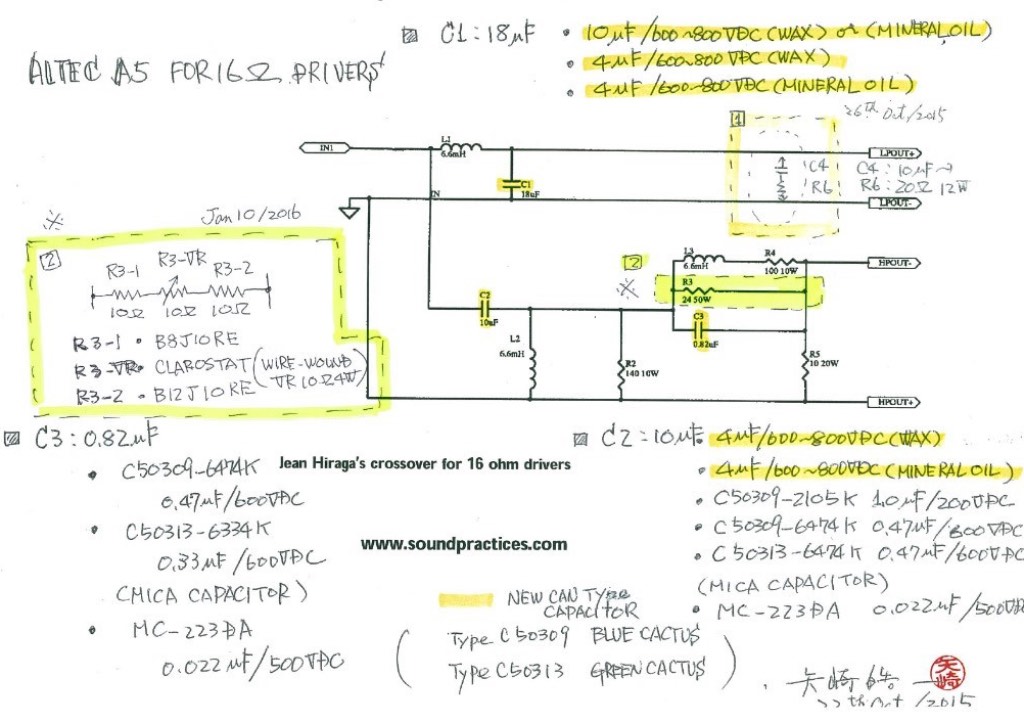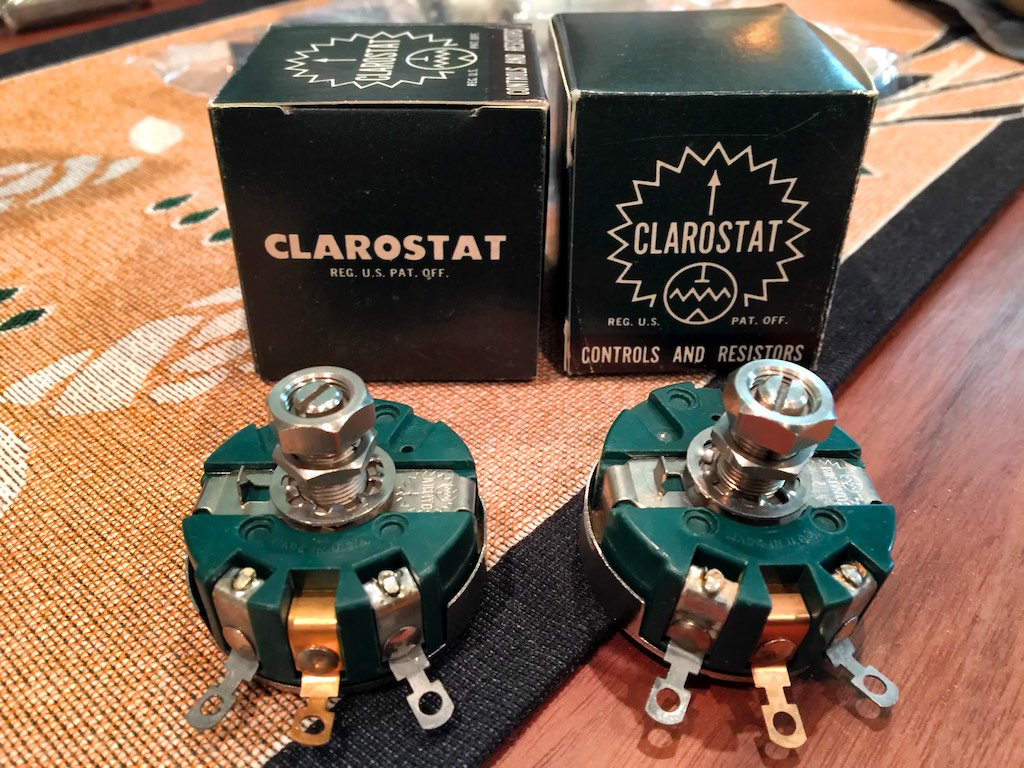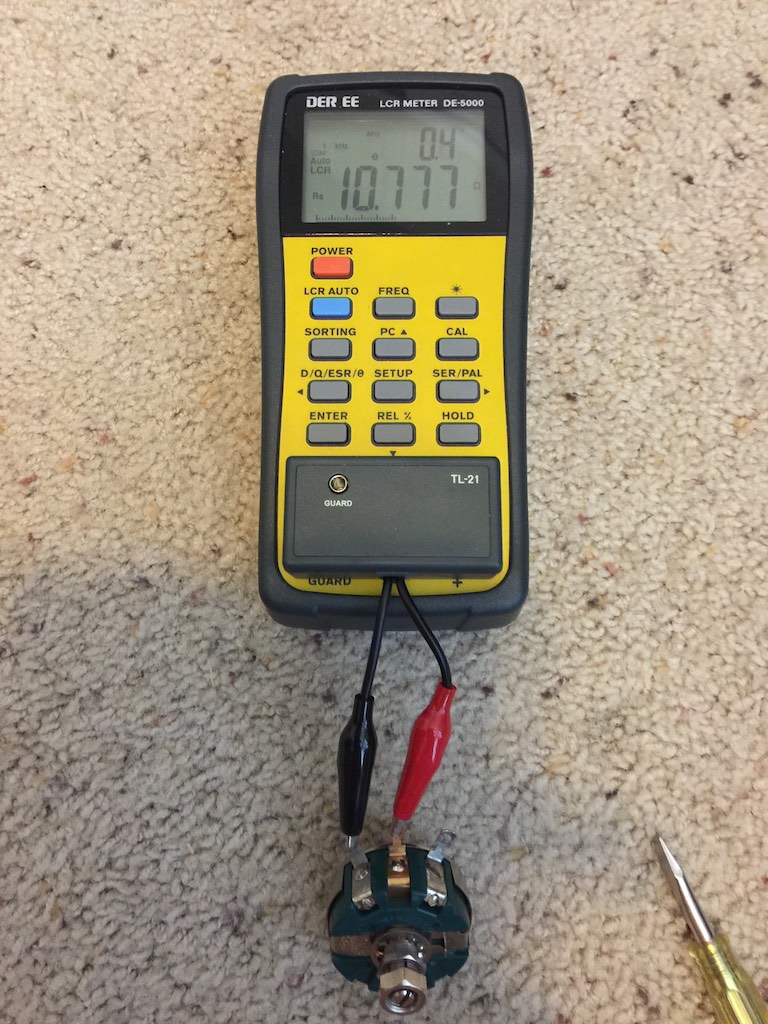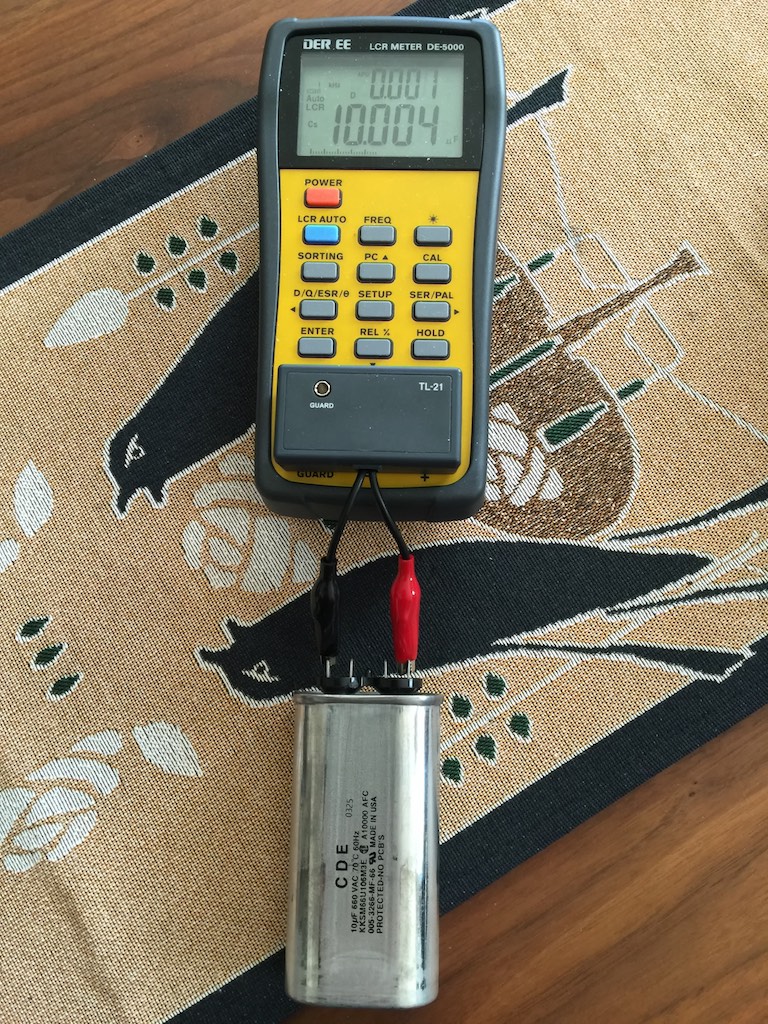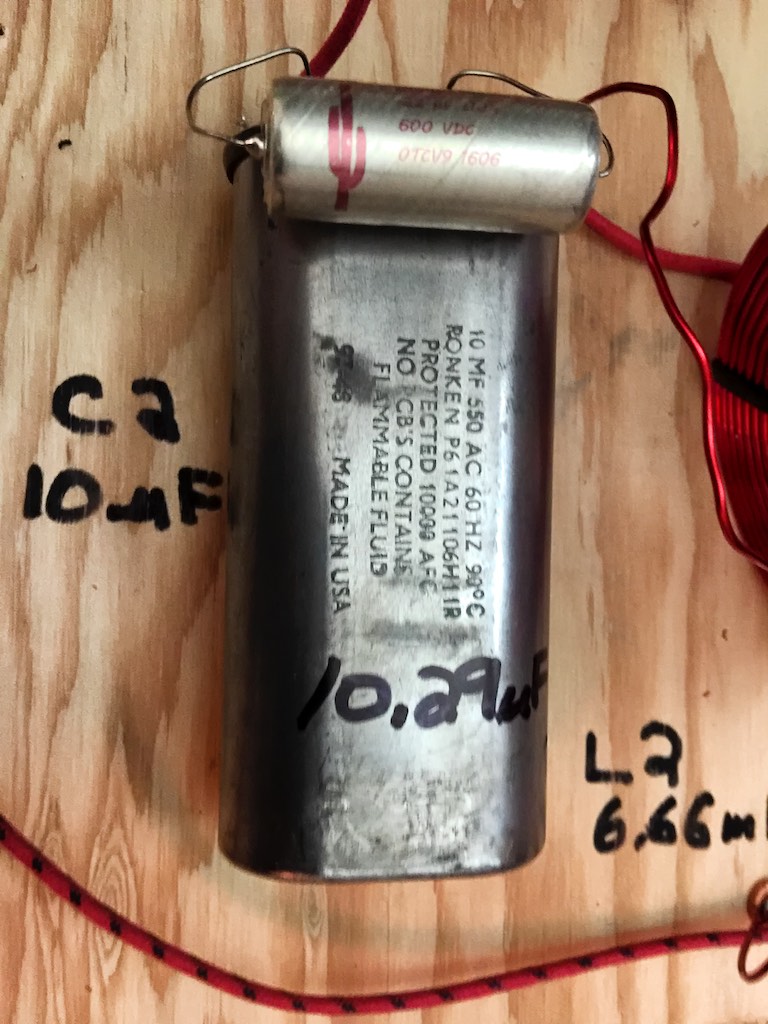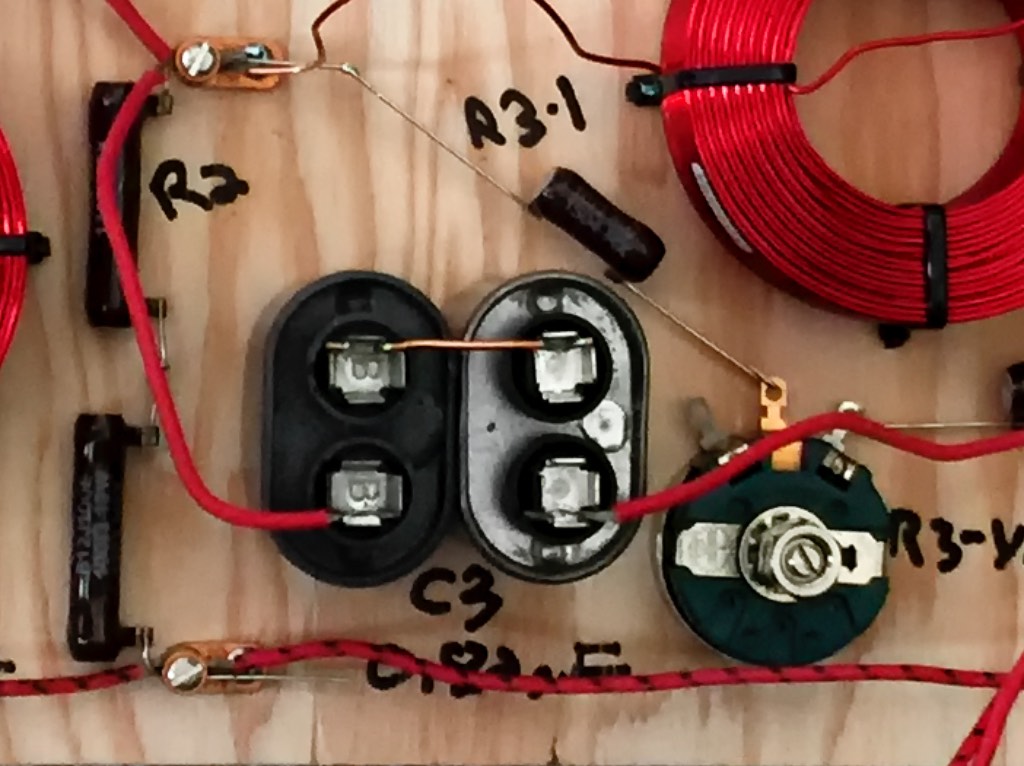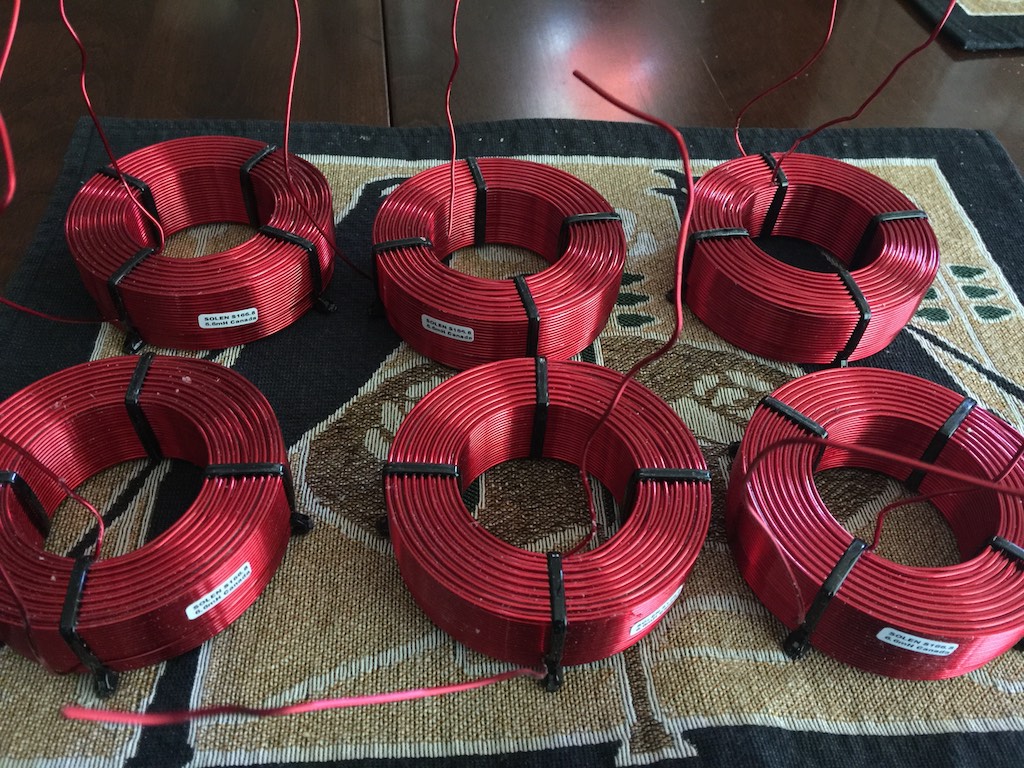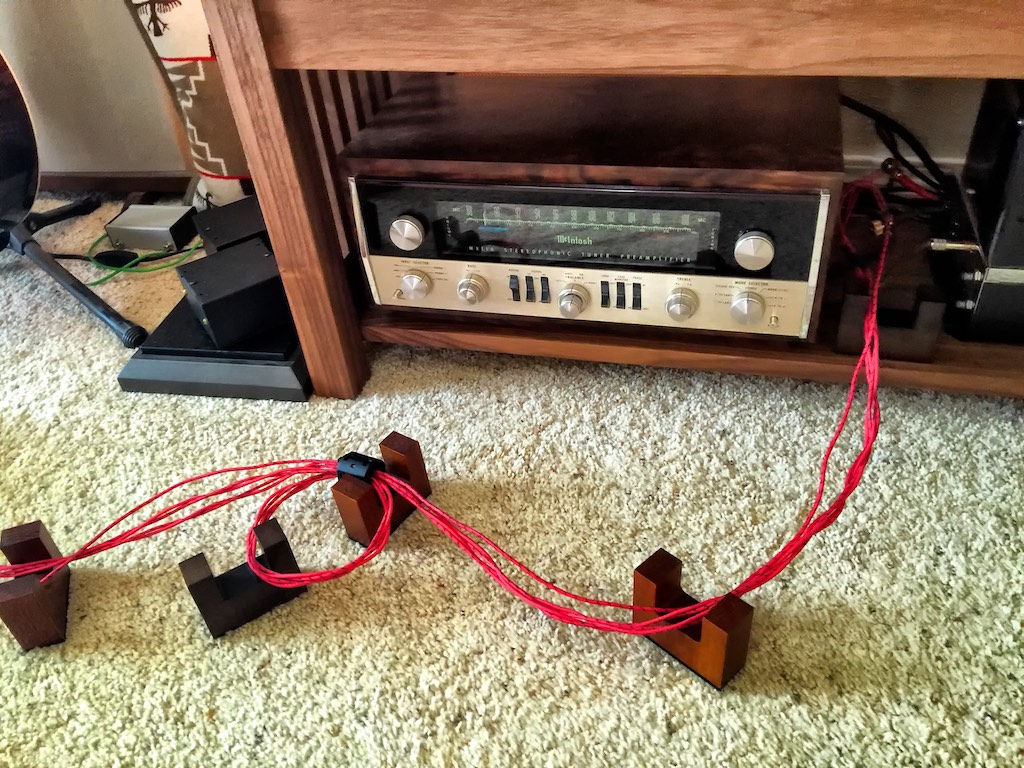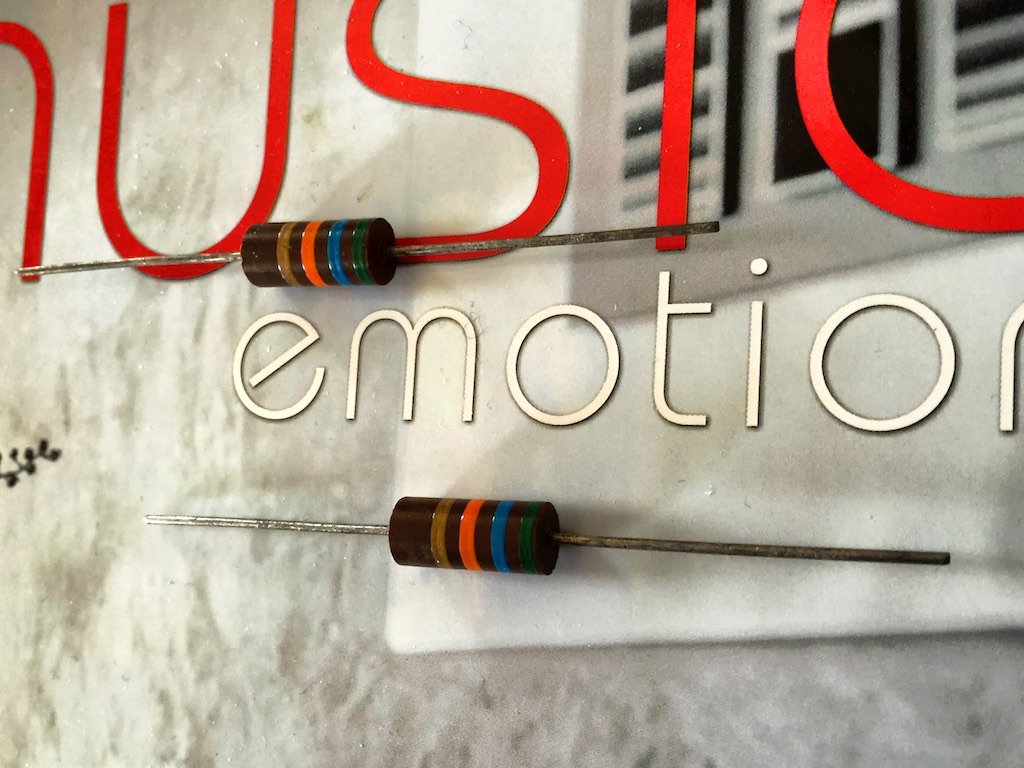I had a nice day of music listening yesterday afternoon with Leo, Pete, and Ron, as we did some listening comparisons with the Altec A5 Voice of the Theatre loudspeakers and their Hiraga-san inspired crossovers.
The Jean Hiraga designed crossovers are about as perfect a match to the Altec A5 Voice of the Theatre loudspeakers as one could hope for, and as a result I'm much further along getting them sorted out than I had anticipated for this short amount of time with them.
Modification 1: Yazaki-san's suggestion that I try adding a Zobel network to the low-frequency section of Hiraga-san's circuit was a very good idea in theory, but in practice it turned out to be a bust from a sonic & musical perspective (that's the Zobel network depicted in the upper right-hand of Hiraga-san's crossover circuit in the diagram above).
With the addition of a Zobel network the sound leaned out dramatically and the tonality collapsed. I immediately took the Zobel network back out of the circuit. It was worth trying, but it didn't pan out for this application.
It appears that Zobel networks can be a hit or miss sort of thing depending on the drivers involved. Pete Riggle, with his 60 plus years of loudspeaker modification & design experience, explained to me in technical terms what he thought was going on with the Zobel networks and why they worked well with some loudspeakers but not others, but his audio engineering explanation went over my head, and I promptly forgot the reasons. Maybe Pete will read this and comment, and reiterate what he thinks is going on with the Zobel's.
The effect of a Zobel network can be a nice addition, as I found with my Harbeth Super HL5 loudspeakers, that I thought were noticeably improved by the addition of them, but my Westminster Royal SE loudspeakers didn't like them at all, having much the same reaction to a Zobel network as the Altec A5 Voice of the Theatre loudspeakers did.
My take on the whole Zobel network thing is that when applied randomly to different loudspeakers it is going to be a hit or miss sort of proposition, and in my case it has been one hit (the Harbeth's) and two misses (the Westminster's and the Altec's). I'm guessing a Zobel network has to be included as part of design process, with accommodating driver designs, and appropriate voicing, to make it blend in sonically & musically in a satisfactory fashion.
Modification 2: Modification 2 that Yazaki-san suggested turned out to be a really nice addition to Hiraga-san's circuit, and helped me get the high-frequencies balanced for the 2dB of extra sensitivity that the ten-cell 1005B Altec horn has over the fifteen-cell 1505B Altec horn that Hiraga-san designed the crossover for (thanks for that bit of information about the 1005B vs. 1505B horns' sensitivity, Steve).
I found the most balanced presentation with the 1005B horns & 288C high-frequency compression drivers was with the Clarostats adjusted all the way up, which brought the high-frequency balance down a bit to blend in better with the 515B low-frequency drivers & 825B bass horn cabinets combination.
As you can see in the circuit diagram above, the stock Jean Hiraga circuit has a 24 Ohm / 50 Watt resistor in the R3 position of the high-frequency circuit in the crossover, and as Steve pointed out in his comment, Hiraga-san designed the circuit for the fifteen-cell 1505B horn, which has 2dB less sensitivity than the ten-cell 1005B horns.
Yazaki-san's suggestion of the 10 Ohm Clarostat connected to the two Ohmite Brown Devil 10 Ohm resistors in series provided for an upper range of 30 Ohms for R3, which turned out to be just about ideal to get the high-frequencies nicely integrated with the low-frequencies. Just for kicks I may order up a quad of of 12 Ohm Ohmite Brown Devil's to substitute in for the 10 Ohm versions, which would expand the adjustment range of the Clarostat up a bit for a little additional experimentation.
R3 Resistor Update #1: After checking into ordering either 12 or 24 Ohm Ohmite Brown Devils I found out Digi-Key doesn't stock them except by special order, with a minimum order of 50, so that adventure is not going to happen. But in a serendipitous moment some 24 Ohm Allen Bradley carbon comp resistors arrived in the mail after I wrote this blog post, so they're in the circuit now while I'm listening to music (I'm on a Miles Davis streak at the moment).
The Clarostat has a high range for its adjustment at 10.777 Ohms ...
... and a low range of of 0.045 Ohm.
With the 10 Ohm Brown Devils in the circuit that gives me an adjustment range of about 20-30 Ohms, and with the 24 Ohm Allen Bradley's about 24-34 Ohms.
Both the Brown Devils and the Allen Bradley resistors sound very good in the circuit, although the Brown Devils with the Clarostat set for 30 Ohms total resistance at R3 sound subjectively brighter than the Allen Bradley's with the Clarostat's set for a total R3 of 24 Ohms. Crazy eh? I'll keep fiddling around with the value of R3 and report back on the results.
R3 Resistor Update # 2: Well it is Sunday morning and I'm having an enjoyable morning of drinking coffee, listening to Miles Davis (Someday My Prince Will Come), and comparing R3 resistors and resistance values.
I've been listening back and forth to the sonic & musical performance of the vintage Allen Bradley carbon comp resistors & the Ohmite Brown Devil wirewound resistors in combination with the Clarostats, and I have come to the conclusion, that hands down, for R3 I prefer the Ohmite Brown Devils for their smooth, natural, presentation, and their excellent overall tone.
I thought the Brown Devils for R3 also gave a more realistic & natural timbral signature for muted trumpet (and horns in general), than did the Allen Bradley's, and provided a better portrayal of tempo, melodies, beat, and dynamics.
The one thing that I noticed with the Allen Bradley's, and it was the deal breaker for me, is that when used in the R3 position they tended to emphasize the lower frequencies of the 1005B horns & 288C high-frequency compression drivers combo in an unnatural way, making the sound bloated & unbalanced in the lower frequencies of its reach.
I've found (at least for this moment in time) that the most balanced presentation with my 1005B horns & 288C high-frequency compression drivers was with the Clarostats adjusted so that the overall resistance for R3 was 30 Ohms, rather than the 24 Ohms specified for the 1505B horns & 288C high-frequency compression drivers that Hiraga-san developed the crossover circuit for.
C2 Capacitor Update #1: I've been whiling away the afternoon fiddling around with the 10uF C2 capacitors. I thought the 10uF Ronken P61 capacitors sounded pretty good, but I got to hankering for trying the CDE 10uF capacitors in C2 just to see what would happen, so out came the Ronken's and in went the CDE's.
The CDE caps were a disaster in C2, causing the lower mid-range to sound muddy, boomy, and otherwise just suck (technical term). The music lost its life and sparkle, and beat sounded plodding and boring. Ugh.
On the (small) positive side of their performance, the highs sounded smoother, more natural, and musically compelling than did the Ronken P61 caps, but not by much, and it certainly wasn't enough to offset their more unpleasant traits.
It did get me to thinking about my recent experiences with the Duelund CAST hybrid capacitors, though, and how much influence the coupling capacitors had on their high-frequency performance. The Duelund CAST hybrid caps sounded like the copper Duelund CAST caps from the lower frequencies on up to the midrange, and a lot like the silver Duelund CAST caps from the midrange on up.
I wondered if I might be able to improve things with coupling caps on C2, so I got out pairs of 0.22uF Green Cactus, Blue Cactus, and Red Cactus Arizona Capacitors to try as coupling capacitors.
First up for listening was the pair of 0.22uF Green Cactus. While the Green Cactus sounded better in some aspects, it was not a clear improvement, so out they came, and in went the 0.22uF Blue Cactus. The Blue Cactus were a definite improvement over the Green Cactus as coupling caps, sounding both richer & smoother. Then I swapped out the Blue Cactus for a pair of 0.22uF Red Cactus.
The Red Cactus really sounded great as a coupling capacitor on C3, and it was particularly noticeable on muted trumpet. That aggressive 'biting' quality of the muted trumpet comes from the relative strength of the higher harmonics compared to the lower harmonics. When the strength of the higher harmonics overpowers the lower harmonics you get that overly shrill 'icepick to the ear' effect. When the strength of the higher harmonics is in balance with the strength of lower harmonics you get the sonic effect of the mute but it sounds smooth and clean through its range. When the strength of the higher harmonics is less than the strength of the lower harmonics a muted trumpet can have a beautiful, sweet, mellow tone.
Trumpet players adjust this effect with their choice of mute to achieve the kind of sound they are looking for in a particular piece of music.
For dialing in muted trumpet (mostly Miles Davis) while voicing my crossover, I was shooting for a sound where the strength of the higher harmonics were in balance with the strength of lower harmonics so that the muted trumpet sounded smooth and clean through its range, and the 0.22uF Red Cactus Arizona Capacitors did a very nice job of that. With the Red Cactus the muted trumpet still sounded piquant like it should, but still smooth, clean, and extended like it should.
I also tried a pair of 0.01uF SPEC Mica-Ruby capacitors as coupling caps, and while not bad, for this C2 application it was not a clear improvement, as it emphasized the higher harmonics a little more, which made the muted trumpet sound a little too 'biting' for my tastes.
The 0.22uF Red Cactus Arizona Capacitors are staying put as coupling capacitors on C2, and they really give a nicely balanced sound that makes for a noticeable improvement over the 10uF Ronken P61 by itself. I really like the Red Cactus in this application as coupling caps.
As the Hi-Fi Collective web site says, the Red Cactus is constructed similarly to the Green & Blue Cactus (i.e. beautifully), but is a "... more 'old school' version made up of a kraft paper dielectric and aluminium foil electrode, impregnated with high purity mineral oils ..."
Ok, now back to the original post ...
By the way, the DE-5000 LCR meter that Yazaki-san sent to use for this crossover project has been incredibly valuable for me in checking capacitance, resistance, and inductance, for the different components in the crossover circuit, and helping me understand what was going on in the circuit. A big "Thank you!" to Yazaki-san for the DE-5000 LCR meter!
C3: The Hiraga-san crossover circuit calls for a 0.82uF capacitor in the C3 position of the high-frequency circuit. As I reported earlier, I tried a pair of CDE motor run caps in series (1uF in series with 4.5uF in series gives 0.818uF) in the C3 position, and they sounded pretty good.
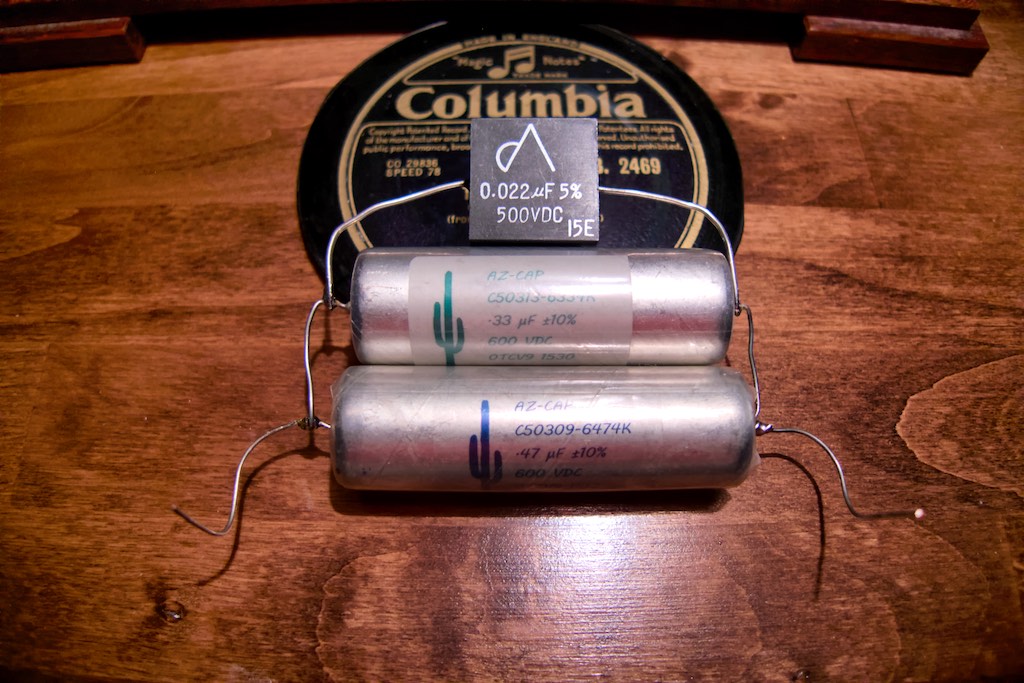
The combination of Arizona Capacitors and the SPEC Ruby-Mica capacitor as recommended by Yazaki-san for C3.
Yazaki-san had recommended the combination of Arizona Capacitors' 0.47uF Blue Cactus & 0.33uF Green Cactus, and a 0.022uF SPEC Ruby-Mica capacitor in parallel for the C3 position (see Yazaki-san's diagram for specifics).
I soldered up the three capacitors in parallel so Leo, Pete, Ron, and I could substitute them in for the CDE's I had put in C3, so I took out the CDE's in C3 and put in the Arizona Capacitors & SPEC combination, and fired the system back up.
As soon as the stylus touched the LP there was no doubt about it, the Arizona Capacitors & SPEC combination for C3 was a massive improvement, and completely slapped down the CDE motor run caps. It wasn't even close!
As a refresher on the Arizona Capacitors' construction, I thought I'd quote the really nice description used on the Hi-Fi Collective web site for them:
The Green Cactus: "We have invested in 3 of their Cactus aluminium foil range of capacitors, all of them are similarly priced but vary in their composition slightly. Here we have the Green Cactus, made up of a kraft paper and Mylar dielectric, with a higher proportion being paper, and aluminium foil electrode, impregnated with high purity mineral oils. The case is hermetically sealed into an insulated electro-tin plated brass tube with glass to metal compression end seals with soft solder to the ends to ensure a complete hermetic seal.The leadouts are tinned OFC copper. These capacitors offer an outstanding performance and a long life."
The Blue Cactus: "... the Blue Cactus, made up of a kraft paper and Mylar dielectric, with a higher proportion being Mylar, and aluminium foil electrode, impregnated with high purity mineral oils. The case is hermetically sealed into an insulated electro-tin plated brass tube with glass to metal compression end seals with soft solder to the ends to ensure a complete hermetic seal. The leadouts are tinned OFC copper."
The 0.47uF Blue Cactus & 0.33uF Green Cactus, along with the 0.022uF SPEC Ruby-Mica capacitor in parallel for the C3 position, gave a very seductive silky smoothness to the range covered by the 1005B horns & 288C high-frequency compression drivers, and eliminated the roughness I was hearing at times with brass instruments and massed strings. The soundstage also opened up dramatically, and went a good 5-feet deeper in back of the front wall than did the CDE's.
Leo, Pete, Ron, and I were all wowed at the transformation brought about by the addition of the Arizona Capacitors & SPEC Ruby-Mica capacitor in C3, so they will stay put in C3 as I continue to try to further optimize the crossovers for the A5 VOTTs.
So what's next?
I have been getting encouragement from a number of you to try some iron-core inductors to see if they offer an improvement in tone, so I may very well look into that.
Rick had suggested I take a look at the Mundorf Zero-Ohm-Coil Foil Coil inductors, which look like real beauties.
Pete suggested that it is the low-frequency section of the Jean Hiraga crossover that would benefit most from the iron core inductors, which lines right up with the Mundorf inductors Rick suggested.
I'm intrigued enough that I have an inquiry in to see if Mundorf could wind me a custom pair at 6.66mH for L1 in the LF section of the Jean Hiraga crossover circuit.
Speaking of bass quality, Pete thinks I can further improve bass quality by optimizing the port dimensions in the 825 low-frequency cabinets.
Pete told me he thought the ports were too big for optimum bass response, so he wants to make some adjustable panels to fit into the ports so I can experiment with reducing the port size and see what effect it has on the A5's bass quality.
That should make for an interesting experiment, so more to come on that.
Here's a bit of a teaser for you.
The vintage McIntosh MX110Z capacitor & resistor adventure with Yazaki-san & Ron-san has been an incredibly valuable learning experience for me, and has been a great encouragement for me to try various resistors & capacitors in my MX110Z, for the phono input resistors at R88 & R90 (left inputs) and R89 & R91 (right inputs), and the 0.1uF capacitors at the C93 & C95 and C94 & C96 positions with a pair of 0.22 uF capacitors, respectively.

Ron-san working on the Capacitor & Resistor Adventure with the vintage McIntosh MC30 monaural amplifiers.
I have continued to experiment with phono input resistors, and have tried a half-dozen different contenders now, but I keep coming back to the vintage 56KΩ / 2Watt Allen Bradley carbon comp resistors as having the best combination of tone and sonics.
No, they are not perfect, but for my tastes they serve the music the best of any of the resistors I have tried at R88 & R90 (left inputs) and R89 & R91 (right inputs), so I am closing out my resistor adventure with my vintage MX110Z on that note (unless of course I come across some other tempting resistor to try!).
The MX110Z capacitor & resistor adventure shall continue as I experiment with 0.1uF capacitors at the C93 & C95 and C94 & C96 positions (or pairs of 0.22 uF capacitors), but it will be without Yazaki-san's, Gary at Tepro, or Daryl at Arizona Capacitors, involvement, who with no explanation, have all ceased communicating with me. The only thing I can assume is that they are miffed about the way the MX110 adventure turned out, which is unfortunate.
For me when I try a modification and it doesn't work out it's not a big deal, I just move on and try something different. It's just a trial-and-error sort of thing to find the best match for a given application for my tastes, and it is not intended to cast a poor reflection upon any of the people or components involved in the adventure.
The power supply modifications of the MX110Z didn't work out. No big deal, it happens. Depending on the application, some things just work out better than others, and that is what subjective reviewing is about for me, reporting on the results as I hear it according to my personal tastes. Apparently not everyone feels the same way.
While that is an unfortunate & unexpected development with those fine gentlemen that makes me sad, and not what I would have wished, I shall move on with the MX110Z capacitor & resistor adventure without them (as well as with the Altec A5 VOTT adventure).
A vintage capacitor adventure is in the works for the MX110Z ...
Which brings me to the teaser I mentioned earlier: You may recall that in an earlier post that I had realized after researching highly regarded vintage capacitors like the Sprague Black Beauty & Bumblebee capacitors, and the Mullard Tropical Fish capacitors, that my MX110Z had the 0.1uF capacitors at the C93 & C95 and C94 & C96 positions replaced with a pair of 0.22 uF Mullard Tropical Fish capacitors before it came to me, which may be part of the reason my MX110Z was so difficult to improve upon.
I don't know if that is something that McIntosh did in later production, or if Terry DeWick made that change during his restoration of my MX110Z (I should probably ask him). When Ron was desoldering the Mullards one of them fell apart, so we were not able to go back to them as a reference.
It may be that the 'British fineness of tone' that Yazaki-san has referred to extends beyond vintage Mullard vacuum tubes to include vintage Mullard Tropical Fish capacitors, and contributed to the exceptionally fine performance I was getting from my MX110Z, so I've ordered some replacements from Hi-Fi Collective to try, and then report back about.
Also, Yves Beauvais at Vintage Vacuum Audio, was so kind as to send me some vintage Sprague Bumblebees to try in the MX110Z, and report on. Now if I can also find some Sprague Black Beauty capacitors in appropriate values, I will be able to report back to you on the musical & sonic performance of that holy trinity of vintage capacitors in the MX110Z - what a treat!
Yves' Bumblebees are on their way to me now, but unfortunately FedEx rather uncharacteristically lost the package containing the Mullard Tropical Fish and are looking for it, so there's a bit of a delay there.
One other thing just occurred to me after mentioning Yves: I read somewhere, a long time ago, that Jean Hiraga considered the vintage McIntosh MC225 to be one of the very best matches for the Altec A5 Voice of the Theatre loudspeakers, which means I'll have to get out the MC225 that I bought from Yves, and report back on the results of that historic combination.
Well that's all for now, but stay tuned, there's lots more hi-fi fun & games coming your way!
Thanks for stopping by, and may the tone be with you!





